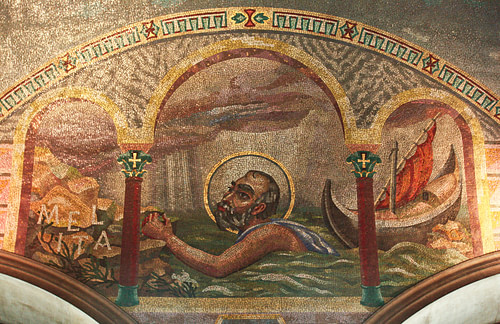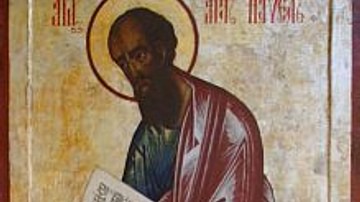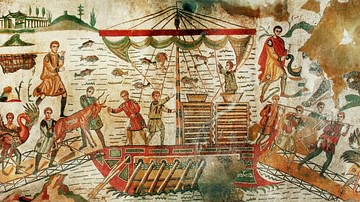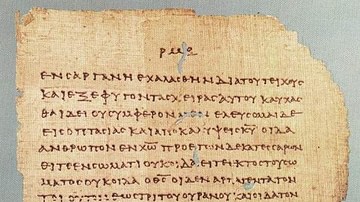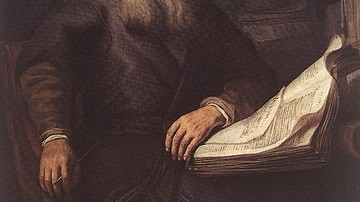The journeys of Paul the Apostle, as the New Testament relates in the Book of Acts, started with his conversion experience on the way to Damascus, after which instead of seeking to thwart the growing Christian movement, he helped spread it. His four journeys by land and sea across great lengths of the Mediterranean and over vast expanses of land in Asia and Europe totaled over an estimated 16,000 km (10,000 mi).

Paul's First Missionary Journey
After persecution in Jerusalem, Antioch was one of the places to which Christians fled, and it was from there Paul began his first missionary journey. Annexed by Pompey the Great in 64 BCE and made the Roman provincial capital of Syria, with an estimated population of 250,000, Antioch was one of the primary cities of the East, along with Alexandria and Constantinople. Located at the northeast end of the Mediterranean on the Persian Royal Road, Antioch benefited from its location at the end of the Silk Road and its proximity to Greece, Anatolia, and Italy. As A. H. M. Jones et al. mention, not only was "its wealth derived from being a center of civil, military, and later ecclesiastical administration of much of the Near East but also from its position on the commercial road from Asia to the Mediterranean" (103).
Besides its own wine and olive oil production and as a center for the fulling of cloth products, silk from China, lapis lazuli from Afghanistan, dye-works from the Levant, and weaved silk from Damascus could all have found their way through Antioch for distribution throughout the northern Mediterranean areas. As it lay on the Orontes River and at the edge of a fertile plain, Antioch communicated commercially with the harbor of Seleucia 26 km (16 mi) downstream on the Mediterranean. As common travelers in ancient times hitched their rides on merchant vessels, the water portion of Paul's trip was aboard a cargo ship performing trade transactions. Thus, it was at Seleucia that Paul boarded a cargo ship to the province of Asia, stopping at the island of Cyprus.
Cyprus, with a prominent location at the eastern end of the Mediterranean, was also known for its wine and olive oil production. A scenario for trade would have been a combination of Eastern goods loaded alongside refined and agricultural products accumulated at Antioch. Then, with a stop at Cyprus for partial distribution, Cyprus' products would have been added for final distribution in Asia.
With fellow evangelist Barnabas and Barnabas' nephew, John Mark, Paul first landed at Salamis on the eastern end of Cyprus after leaving the port city of Seleucia and sailing west toward Asia. Like with many of his subsequent stops, Paul first visited the local synagogue, attempting a conversion of the Jews to Christianity. From Salamis, heading west, walking nearly the length of Cyprus, Paul and Barnabas came to Paphos, their point of departure for Asia. At Paphos, the proconsul Sergius Paulus would become a convert.
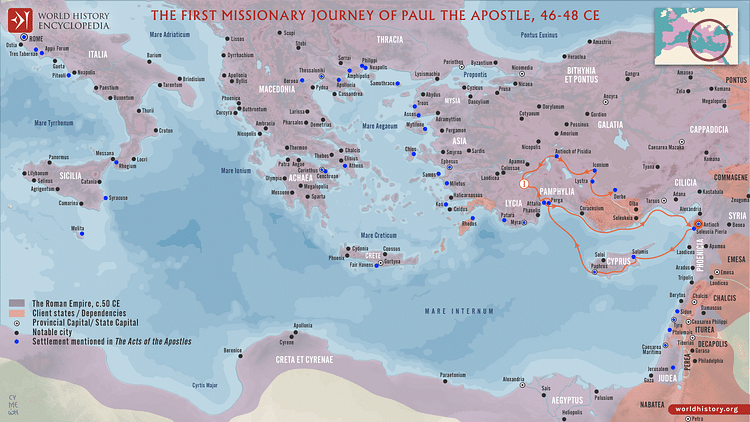
Heading to Asia from Cyprus, Paul's ship stopped at Perga in Pamphylia, in southwestern Turkey today. From Perga, John Mark departed for Jerusalem as Paul and Barnabas pressed on into Asia. At their first stop in Antioch of Pisidia, at the synagogue, Paul preached the history of Israel as he weaved in the story of John the Baptist and Jesus of Nazareth, said to be a descendant of David, as the resurrected Savior, son of God. Though Paul and Barnabas initially gained Jewish and Gentile converts, a faction of opposing Jews expelled them from the city.
At Iconium, with similarly mixed results on learning of a plot to kill them, Paul went on to Lystra. As many in Lystra were worshipers of gods and their idols, Paul preached they should turn from worshiping "things" to worshiping the "living God" (Acts 14:15). When some hostile Jews came from Antioch and Iconium and won the crowd over, both groups stoned Paul. Thinking he was dead, they dragged Paul to the outskirts of the city. When some brethren came to retrieve the body, remarkably Paul had recovered and went back into town. The next day, Paul traveled east for Derbe. With his mission ending on a more positive note, large numbers rallied at Derbe to Paul's message. Deciding to head home, retracing their steps through Lystra, Iconium, and Antioch, after appointing elders in each church, the apostles went on to Perga; then, after preaching there a bit, they boarded a ship for a short junket west to the port city of Attallia, then from there they sailed back to Seleucia, then traveled up along the Orontes to Antioch.
Paul's Second Missionary Journey
Paul's second missionary journey started with a land route. After Paul and Barnabas returned from Jerusalem, where it was decided what was required of Gentile converts, Barnabas took John to Cyprus while Paul took Silas to Asia. Heading north then west through Syria and Cilicia, he strengthened churches along the way "to remain true to the faith" (Acts 14:22). When he visited Derbe and then Lystra, he took on Timothy, a native of Lystra, to join them in their travels, perhaps because Timothy's mixed parentage could make the evangelists more appealing to Jews and Greeks.
After presumably visiting Iconium and Antioch of Pisidia, Paul and his companions traveled west. At Troas, Paul boarded a ship headed northwest to disembark at Samothrace. Through Neapolis, he walked to the nearby city of Phillipi, a Roman colony on the via Egnatia, a major Roman road connecting the Dardanelles and the Adriatic. Staying several days in Phillipi, Paul befriended and stayed with Lydia, a wealthy lady, a dealer in purple cloth whose whole family became believers.
Passing through Amphipolis and Apollonia, Paul articulated the Christian faith at the local synagogue at Thessalonica, where some Jews and many Greeks were won over. Those in opposition claimed Paul and Silas were sowing sedition by defying the Roman emperor as they championed another king named Jesus Christ. Subsequently, a believer named Jason, who hosted the apostles, was dragged before the city officials and made to post bail for the apostles. With apparent danger to their lives, Paul and his company left that night for Berea. The apostles found the Bereans more amenable to their message, but when some Jews from Thessalonica came to oppose them, Paul went ahead to Athens, leaving Silas and Timothy to catch up with him later.
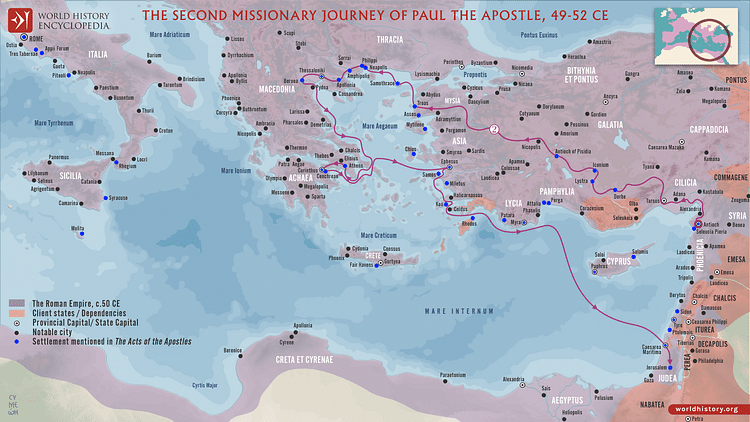
At Athens, after his usual initial efforts at the synagogue, he went to the marketplace to preach. Some Stoics and Epicureans came to debate him; some said he was a babbler, others that he was promoting foreign gods. They took him to a meeting at the Areopagus, where he proposed that instead of venerating objects made by hand, worship should be directed toward the one creator, ubiquitous, living God. When he expounded on the idea of a resurrection, some at the meeting scoffed. After days of preaching at Athens, seeing he was making little headway, Paul moved on to Corinth to preach there for a year and a half. At Corinth, Paul befriended Priscilla and Aquilla, who, with other Jews, were expelled from Italy by the emperor Claudius (r. 41-54 CE).
After Silas and Timothy came to Corinth, Paul decided to work solely with the Jews. Though his efforts were met with opposition, Crispus, the synagogue leader, and his whole household, along with many other Corinthians, were converted and baptized. However, hostile Jews brought Paul before Gallio, the proconsul of Achaea, claiming he was breaking their laws. As their claims were not addressed by Roman law, Gallio dismissed them. Bringing Priscilla and Aquila with him they boarded a ship at Corinth’s port of Cenchreae, likely loaded with refined goods, and headed for Ephesus. He preached there with a better reception; synagogue members asked him to stay longer. Promising he would come back if it were God's will, he left Priscilla and Aquila to carry on at Ephesus. From Ephesus, Paul embarked on a ship with the long downhill run for the trade center of Caesarea Maritima. From there, as was his custom, he first visited Jerusalem, 103 km (65 mi) southeast, before heading north to Antioch.
Paul's Third Missionary Journey
On his third journey, Paul traveled through Asia, encouraging and strengthening the disciples, and spent two years evangelizing in Ephesus. Ephesus was the center of worship for the goddess Artemis. Her great temple received substantial offerings, and a competing religion might subtract from that. Besides this, Acts 19:23-27 reveals there was a big demand for the silver shrines of Artemis – presumably for homes and places of meeting. Demetrius, a silversmith and the main builder of the shrines, incited his fellow workers against Paul, likely because Paul's preaching against idol worship posed a real threat to their business. Piling on, Demetrius also explained that the honor and place of Artemis and her temple were threatened. Furious, they began to shout, "Great is Artemis of the Ephesians!" Moving through the city, their demonstration snowballed as they grabbed two of Paul's travel companions from Macedonia and entered the Great Theatre, still shouting. Wanting to address the crowd, Paul was held back by his disciples. Then, when Alexander, a Jewish leader with standing, attempted to calm the crowd, he was shouted down. Only when a city clerk spoke, implying punishment from Rome for rioting, did the crowd listen. Yet, after the crowd dispersed, the disciples knew Paul's life was still in peril, so he quickly left to begin the last legs of his final mission.
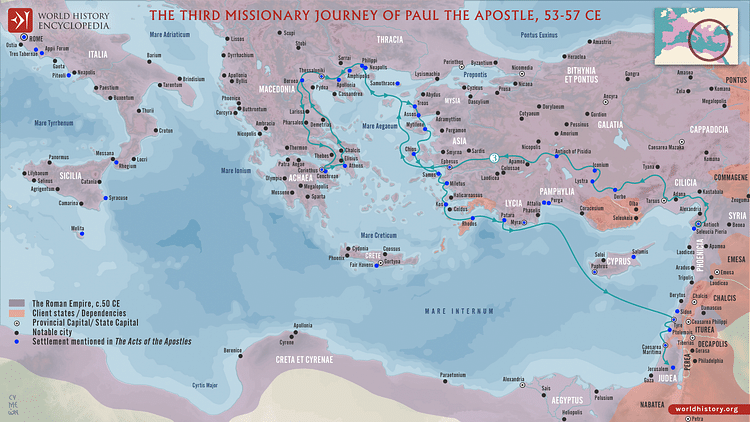
From Ephesus, Paul likely took the Troas/Phillipi water route, met the brethren of Macedonia, gave them words of encouragement, and then went on to Achaea. When he was about to sail home for Syria because of a plot against him, he decided to go back through Macedonia. With seven travel companions from the province of Asia (western Anatolia), Berea, Thessalonica, Derbe, including Timothy from Lystra, they went on to Troas to wait for Paul and Silas, who would catch up after the Festival of Unleavened Bread.
On his return trip back over the upper Aegean, Paul stayed for seven days at Troas. As Acts 20:7-12 relates, on the evening before his departure, brethren had gathered in an upper room to hear Paul speak. The gathering must have been sizable; many wanted to see him before he left. In a three-story hall, Paul spoke longer than usual, until midnight. Being the sailing time of year, it was probably late spring or summer. Because of the heat with so many bodies packed in an upper room or from the fumes of the lamps, a young man sitting on a window ledge had fallen asleep. When he fell three stories to what everyone thought was his death, Paul took him up in his arms, and to the brethren's great comfort, announced he was alive. With his final mission ending, Paul conversed with the brethren until morning before leaving for Jerusalem. From Troas, deciding to walk by land, Paul sent the others by sail to Assos, where they would meet up.
Typical of commercial activity, with many stops unloading and picking up goods, Paul's trip back east involved several junkets along the way. From Assos, they would sail to Mitylene. The trip from Mitylene to Miletus took three days, with two stops at Chios and Samos. Arriving at Miletus, an important Ionian port serving Ephesus, with an apparent layover, Paul had time to have the elders of Ephesus come visit him. The trip to the Lycian port of Patara, a commercial center for Anatolia, involved two stops along the way, at Kos and Rhodes. At Patara, Paul boarded another ship for the longer non-stop route to Tyre. While his usual point of disembarkation for Jerusalem was Caesarea, Paul's ship stopped at Tyre "to unload its cargo" (Acts 21:3). Paul stayed a week with brethren at Tyre then sailed for Ptolemais where he stayed a day. At Ptolemais, Paul boarded a ship for Caesarea, his final stop by water on his final missionary journey.
Despite the dangers that awaited him in Jerusalem and warnings from the brethren at Tyre, Paul went to give his customary report to the elders and the apostle James. Afterward, attending the temple for a rite of purification, he was grabbed by some Jews from the province of Asia, accusing him of sedition. Then, when a riot ensued surrounding the incident, Paul was arrested by the Roman commander and held at the Roman barracks. Wanting to hear the charges against Paul, the commander took him before the Sanhedrin and chief priests. While some Pharisees believed he was innocent, others plotted to kill him. When the plot was found out, a regiment of infantry and cavalry took Paul to Antipatris and then on to Caesarea. At Caesarea, with hearings before Felix, the Roman governor, then Festus, his successor, Paul was accused by the high priests as "ringleader of the Nazarene sect" of starting riots and desecrating the temple (Acts 24:5). As he was held by Felix for two years, with no proof of the charges, when Festus came, he appealed that his case be heard in Rome.
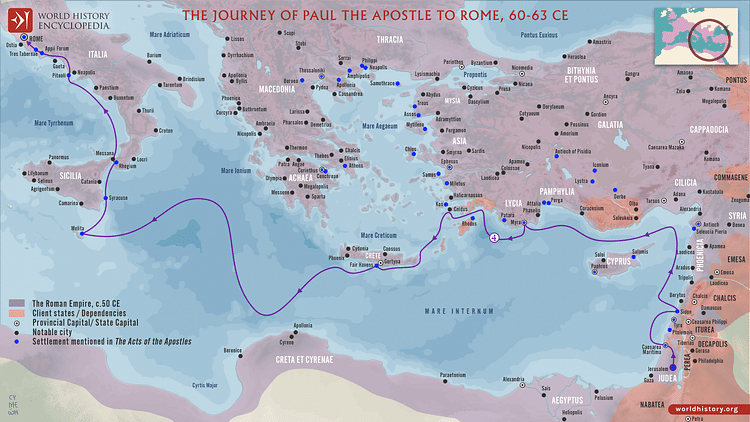
Paul's Final Journey
Like his missionary trips, Paul's trip to Rome would not be uneventful. It was late fall, and traffic was coming to a standstill in the Mediterranean because of the winter storms. Yet a ship owner, pushing the envelope, ordered a vessel to be loaded and prepared to sail. Adding to the cargo were prisoners and soldiers under the command of Julius, a centurion. One of those prisoners was Paul.
After leaving Caesarea for Myra, a grain storage center, they stopped just up the coast at Sidon to pick up more goods. Leaving Sidon, Paul's ship sailed north, but this time, as it approached the northeast corner of the sea, instead of bending west with ease, as it would during warmer months, Paul's ship got hit with strong northwest winds, requiring it to use the leeward side of the island of Cyprus. Continuing west, with difficulty, the ship finally made it to Myra. Finding an Egyptian grain ship headed for Italy, Julius transferred his prisoners over. Inching west for Europe while hugging the coast of Asia, the ship was hit with even stiffer winds. As Acts 27:7 relates, this forced the pilot to turn south for the leeward side of Crete. Approaching the island from the east, they came to the bay of Fair Haven. On the southeast side of the island, it would offer cover, but with the lower-lying Messara Valley north of the bay, shelter from northwest winds was not great. Fair Haven was not the ideal place to spend the winter, and just 12 miles west lay the bay of Phoenix in the shadow of the White Mountain range, offering greater protection from winds.
Rare for that time of year, a warm breeze from Africa arrived. Riding the gentle southern breeze for Phoenix was tempting. Paul was against the idea, but the captain and the owner talked the centurion into it. As they cruised west along the Cretan coast, suddenly, without warning, a severe northeaster hit with hurricane-like winds and waves. Attempting to ride out the storm, they unfurled the mainsail and dropped anchor from the bow to face the teeth of the storm. But the wind was so strong, and waves so big, the anchor's tether only accentuated the violence to the ship. Thus, seeing they "could not head into the wind," they raised the anchor, set a foresail, and "gave way to be driven along" by the storm (Acts 27:15). Afraid they would run onto the inextricable Syrtis sands of Africa, they let down anchors from the stern, to slow their progress. After they reinforced the ship's hull with ropes on the second and third day, they jettisoned the cargo and tackle. For many days, they drifted violently along. Finally, after all hope for life was abandoned, on the 14th night, the sailors suspected they were approaching an island. As they approached land, they cut the anchors loose and made for shore. Suddenly, though, with a jolt, the ship hit rocks and began to break apart. Julius ordered all who could swim to make for land and the rest to grab pieces of the ship. All 276 lives were saved, and they were on the island of Malta. Finishing the winter out at Malta, the inhabitants gave Paul's contingent the supplies they needed to set sail.
Traveling on an Alexandrian ship that had also wintered at Malta, Paul's contingent sailed first to Syracuse, where they stayed for three days, then sailing and overnighting at Rhegium, they journeyed another day to arrive at the port city of Puteoli where they spent a week with brethren. Since Rome's port (Ostia) was not yet enlarged enough to berth the larger grain ships, Paul traveled north from Puteoli by land 240 km (149 mi) on the Appian Way. After a visit from brethren at the Forum of Appius and the Three Taverns, Paul finished the final leg of his final journey. After arrival in Rome, the New Testament says that Paul, though under house arrest, was able to preach to the Jews (again with mixed results) and host guests to whom he proclaimed his message. Finally, while some maintain Paul was killed in Rome, some early church writers claim he was released and went to Spain. Either way, it is generally agreed Paul was soon martyred for the message he spread so widely.

